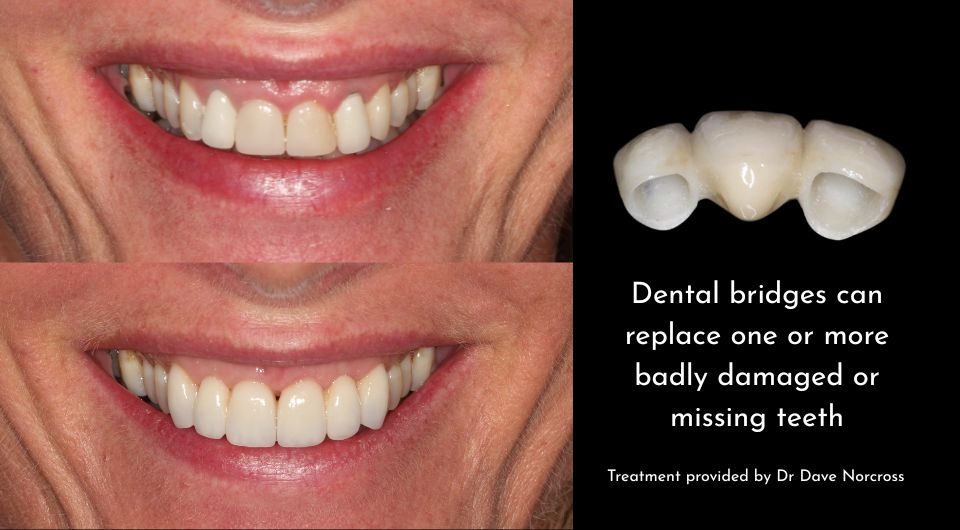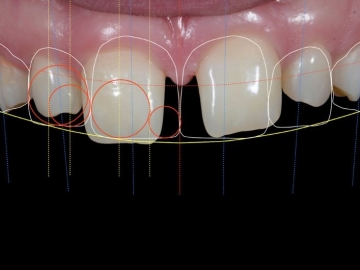
Posted on: 15 May, 2025
If you need to replace one or several teeth, a dental bridge can be a cost-effective option. Find out more with Mount Lawley Dental.
5 minute read
Missing teeth can cause a number of functional and aesthetic problems, from causing difficulties chewing food and speech to affecting one’s willingness to smile. Without their support, neighbouring teeth may also shift and become misaligned over time. If you’re missing one or more teeth in a row, your dentist might talk to you about a dental bridge.
A fixed dental bridge has several advantages over a removable denture and is more affordable than a permanent dental implant, but there isn’t one treatment solution for everyone. Read this guide to understand the pros and cons of dental bridges as a solution to replace missing teeth and contact our dentists in Mount Lawley to discuss your own smile needs.
A dental bridge is two or more prosthetic teeth that are fixed in place by a dentist to ‘bridge’ a gap between healthy teeth. These replacement teeth (or pontics) are usually attached to crowns fitted over neighbouring teeth on each side of the gap, but they may also be attached using clasps or supported by a dental implant in the jaw (known as a fixed implant bridge).
Bridges and crowns are custom designed to blend in seamlessly with your natural teeth, restoring the function and appearance of your smile.
Bridges and accompanying crowns can be made from different materials, depending on your preferences and budget:
A bridge can be supported in several ways, depending on your preferences and where it’s located in the mouth:
Not every dentist uses all four dental bridge types however, most will use a traditional bridge and implant bridges, including our dentists at Mount Lawley Dental
To find out more about types of dental bridges and other solutions for missing teeth, call our dentists today on (08) 9227 8777.
Your dentist may recommend a bridge as a suitable option if you need to replace one, two or several adjacent teeth, offering a number of advantages over removable dentures or dental implants.
Functional benefits
Replacing a tooth can restore the ability to eat and speak normally. You won’t have to avoid certain foods, which could lead to nutritional deficiencies or digestive problems.
Aesthetic benefits
Bridges are designed to look like natural teeth and can be colour-matched to the surrounding teeth for a seamless finish. Filling a gap also prevents the surrounding teeth from shifting out of place over time.
Comfort and stability
Less stable than implants and far more stable than removable dentures, bridges are fixed in place, making them less likely to come loose. They can also cause less irritation and discomfort in the mouth like dentures can.
Fast treatment
Getting a dental bridge involves several visits to the dental clinic but has a shorter recovery time than a dental implant, which involves surgery, possibly sedation and a longer healing process.
A 2009 study found that a dental bridge was a more cost-effective solution for replacing a single missing tooth compared to dental implants, making it a more accessible option for people on a budget.* While a bridge usually costs more than dentures, a bridge can last longer on average before it needs to be replaced, usually every 10 to 15 years on average or longer depending on how well teeth are cared for.
* Bouchard P, Renouard F, Bourgeois D, Fromentin O, Jeanneret MH, Beresniak A. Cost-effectiveness modeling of dental implant vs. bridge. Clin Oral Implants Res. 2009 Jun;20(6):583-7. doi: 10.1111/j.1600-0501.2008.01702.x. PMID: 19530315.
Low maintenance
A fixed bridge is easy to care for, with no special cleaning or storage requirements like dentures. Normal brushing and flossing and a healthy diet are usually enough to keep your bridge and the surrounding teeth and gums healthy.
The cost of a bridge varies depending on the type of bridge, the material it’s made from and how many teeth it’s replacing. Most bridges also involve placing crowns over the surrounding teeth, which will be included in the total cost.
At Mount Lawley Dental the cost of a traditional 3-unit dental bridge starts from $4959, this includes an indirect bridge pontic (#643) and two dental crowns (#613 x 2).
Some health fund policies may partially cover the cost of bridge and implant treatment or related expenses. Our staff at Mount Lawley Dental can help you find out what you’re eligible to claim for.
We also offer flexible payment plans to help you break down your treatment cost into more manageable instalments, with interest-free options available.
Your dentist will explain what a bridge treatment involves during your initial consultation. Replacing a tooth with a bridge requires at least two visits to the dental clinic and regular six-monthly check-ups thereafter.
Consultation and treatment planning
Your dentist will examine your teeth and gums, take an x-ray, and ask about your medical history and other risk factors to assess your suitability for treatment. If you decide that a bridge is the right choice, your dentist will create your treatment plan and give you a price quote.
Preparing your teeth
If the bridge will be supported by crowns, your dentist will prepare these teeth by removing some enamel (usually between 0.5mm – 1mm for zirconia crown) so the crowns don’t appear bulky and stick out. They will then take impressions of your mouth that a dental technician will use to design your custom bridge and crowns. A temporary denture may be placed until your next appointment.
Fitting your bridge
Once your bridge has been prepared, your dentist will call you back for a fitting appointment. They’ll check your bite and that the bridge feels comfortable before cementing the bridge and crowns to your teeth.
A dental crown treatment process is similar to a bridge treatment process. Learn more about What to Expect When Getting a Dental Crown.
Recovery and aftercare
Your dentist will instruct you about how to care for your bridge and your mouth after treatment and in the long term to avoid problems. They may also schedule a follow-up appointment to check your progress after a few weeks.
Once fitted, a dental bridge can typically last for 5–15 years or longer, with some lasting for decades or even a lifetime. How long your bridge lasts depends on its material and how well you care for the bridge, your oral hygiene and lifestyle habits.
While bridges and crowns don’t need special care, it’s important to follow a proper oral hygiene routine that involves twice-daily brushing, flossing, limit sugar in your diet, and avoid bad habits like smoking to avoid problems like tooth decay. Diseases that affect the underlying teeth and gums can cause a bridge to fail.
Your dentist may also advise avoiding very hard or sticky foods that could damage or dislodge the bridge. It’s also important to keep up with your routine dental visits so your dentist can catch and treat any possible problems early and lower your oral health risks.
Most people with missing or badly damaged or decayed teeth are eligible for bridge treatment, but some conditions could make you unsuitable. You may be a candidate if:
Your dentist will make sure you know all your options for teeth replacement so you can make a fully informed decision.
A bridge isn’t always the best option. It might not be the best choice for you if:
A dental bridge isn’t the only solution for missing teeth. Depending on your circumstances, your dentist might also discuss:
It’s not always necessary to replace a missing tooth if it’s not causing problems, but the adjacent teeth could shift over time without support and the jaw bone underneath the gum will start to resorb prematurely without the stimulation of tooth roots.
If you want to know more about bridges and other options for replacing teeth, get in touch today to schedule an initial consultation with our dentists in Perth. Call us on (08) 9227 8777 or book an appointment online. We welcome patients from Highgate, Inglewood, North Perth and all nearby areas.
1. Bouchard P, Renouard F, Bourgeois D, Fromentin O, Jeanneret MH, Beresniak A. Cost-effectiveness modeling of dental implant vs. bridge. Clin Oral Implants Res. 2009 Jun;20(6):583-7. doi: 10.1111/j.1600-0501.2008.01702.x. PMID: 19530315.

5 Facts on Digital Smile Design

How Much Does a Smile Makeover Cost

How Does Ageing Change My Smile